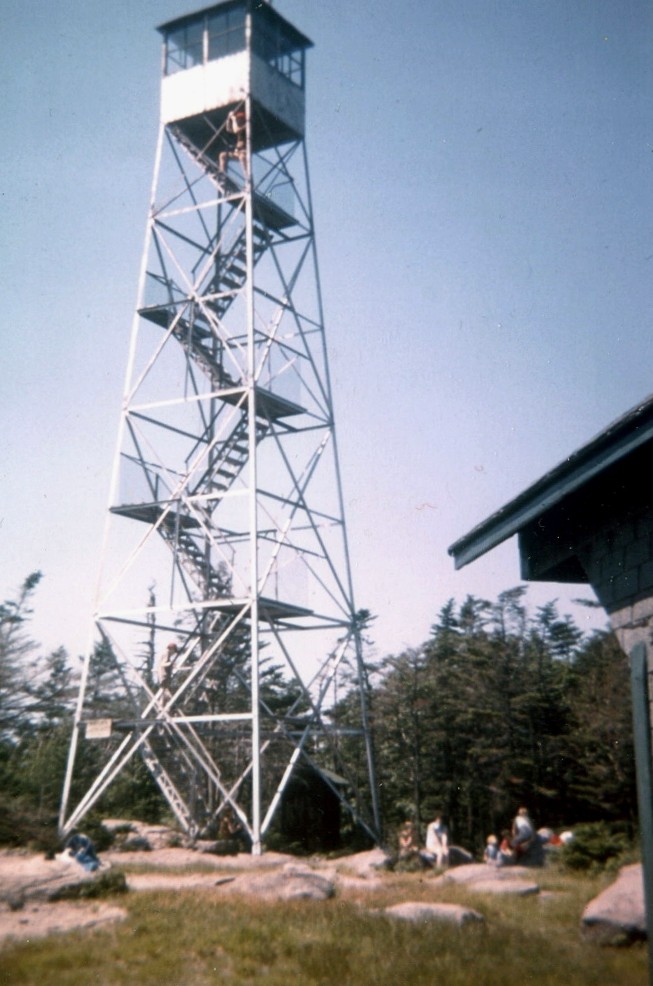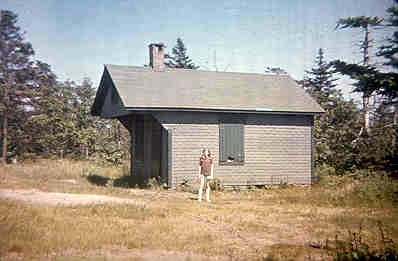



5500 years ago a peat bog formed, with balsam fir being dominant along with yellow birch, cinnamon ferns and wild raisins. While the Catskills do have a number of higher elevation bogs, this one is unique due to its high elevation of 3700 feet. Extensive studies done by Dr. Mike Kudish that establish this information include pollen dating done in 1985 and core sampling done in more recent years using radio carbon dating. This information gives an important look at what the mountaintop may have looked like 5500 years ago and how little it has changed botanically.
The first fire tower on the top of a mountain in New York State was placed at the summit in 1887 to protect and watch over the lands of the privately owned Balsam Lake Club.
In 1901 that first wooden tower was struck by lightning and burned to the ground.
In 1905 a second wooden
tower was built at the summit by the Balsam Lake Club.
In 1909 the State of New
York assumed ownership of the tower and summit, built a road to the
summit and the first Observer, Mike Todd built the first cabin.
In 1919 the State of New York erected a 47 foot Aeromotor Steel tower at the summit. Getting the steel to the summit of the mountain was not an easy task. Local horses and wagons were hired to take the steel to the top. En route, they encountered several steep pitches where the horses were unable to pull the heavy loads. Some problem solving occurred which made for a long day, but finally all of the steel was delivered to the summit and the men and their horses returned home safely, though much later than expected. The State of New York had 4 crews that were solely dedicated to erecting towers throughout the state. Despite the lack of technology, motor vehicles, and power tools, they became so proficient that they could have a tower completely operational in just 10 days. Per the Conservation Annual Report of 1919 - “All towers in place with the exception of Balsam Lake Mountain, to be erected in early spring of 1920”.
In 1930, a second cabin
was erected at the summit -per the Conservation Department Annual
Report of 1931- Standard Cabin construction to furnish livable
quarters where Observers are required to remain on continuous duty
was done.
(There are many incorrect references on the internet and elsewhere to a tower built in 1930, but it was the cabin that was built at this time).
13 Observers were on duty from 1911 to 1988, with the last full time Observer in 1971.
The site is listed on the National Historic Lookout Register and the National Register of Historic Places.
In 1950 there was a major windstorm which created intense blow down – M. Kudish
The tower was closed for good in 1988.
In 1875 there was a
turnpike that went from the Dry Brook Valley to the Beaverkill
Valley, known as the Turner Hollow/Old Tappan Road. Parts of this
road remain as part of the Dry Brook hiking trail to Balsam Lake
Mountain.
The 1901 Beers atlas
states the Turner Hollow/Old Tappan Road was rerouted to its current
location. The Balsam Lake Club often traveled this route to get to
the train station in Arkville.
In 1997 a new trail was constructed from Alder Lake/Coykendall Lodge to connect near the summit of Balsam Lake Mountain.
Two lean-tos, one dating to 1936 with a dirt floor and another from 1960 were determined to be above 3500 feet. With the assistance of the 3500 Club, the Dec built a new lean-to located below 3500 feet.
Beaver Meadow lean-to was built in 1997.
C. 1970 the current cabin was built.
Between 1988 and 2000, the tower and cabin fell into a state of disrepair. Vandals broke into both, windows were broken, and both the cabin and the tower were exposed to the elements, and were inhabited by the wild animals that lived at the summit.
In 1998, the Friends of Balsam Lake Committee was formed. Under the leadership of local businesswoman Karen Harris, plans were made to have the Friends gather volunteers and raise funds to begin restoration efforts. Various fund raising efforts and events took place, including a benefit concert that was held at Belleayre Ski Center that raised nearly $1000.00, a mail solicitation, and “selling” the tower steps and landings to donors. Each step and/or landing that was “sold” had a small plaque honoring the donor. A second benefit concert drew in an additional $200.00 for the tower, bringing the total funds to $16,000.00. A group of landowners in the Beaverkill Valley raised additional donations totaling $10,000 that were donated in memory of David Eames, a resident of the valley who had a passion for the fire tower and had recently passed away.
Actual construction on the tower began in the Summer of 1999. New stairs, landings and fences were installed on the tower. DEC Operations staff and forest rangers repeatedly transported materials up the mountain, and made it possible for the roofer to install a stainless steel roof. New windows for the tower cab were also rebuilt using the originals as a template by a local craftsman.
DEC Operations staff had also transported eight cross braces, bolts, as well as the new windows up to the summit. According to one of the AmeriCorps volunteers who recently visited the tower, the cabin was so heavily inhabited by porcupines that those working on the refurbishing project chose to sleep on pile of lumber outside rather than inside. They also relate that the materials that were needed for the project, including those mentioned above were not able to be transported up the steep hills, but rather AmeriCorps volunteers and DEC staff had to carry the large, bulky, and very heavy angle irons the last half-mile up the mountain in gale force winds.
By the end of 1999, restoration of the tower was nearly complete, pending the installation of the cross braces, a railing in the observation cab and new bolts. The ironwork installation was completed in the Spring of 2000. The tower officially reopened on June 3, 2000 with a large crowd in attendance. The following year, the second and third level cross braces were replaced.
A large group of volunteers has been responsible for manning the tower every weekend from Memorial Day to Columbus Day in the years since. These volunteers greet visitors, give the history of fire towers in New York State and particularly within the Catskill Park and on Balsam Lake mountain. They relate the history of wild land firefighting and share the tools of the trade which are now on display in the tower and the cabin. The volunteers are also responsible for the upkeep and maintenance of the tower and cabin.
The summit is home to a large number of birds and wild animals. It is common to see black bear, bobcat tracks, snowshoe hares, deer, and the summit is even home to a large population of garter snakes.
The Balsam Lake Mountain Wild Forest constitutes 13, 500 acres. Within that Wild Forest there are 22 miles of hiking trails. In addition to Balsam Lake Mountain itself, you can enjoy the trails around Alder Lake and Kelly Hollow for hiking, skiing, and hunting. At a height of 3723 feet, Balsam Lake Mountain is one of the 35 peaks that are over 3500 feet that must be climbed to become a member of the Catskill 3500 Club. On a clear day, one can see 25 other Catskill high peaks from the tower. On clear days, the summit enjoys views of up to 75 miles in some directions. The Blackhead Range in the Windham area, nearly 30 miles away can be seen, along with several other fire towers (Utsyantha, Hunter, and Redhill). The New Jersey state high point monument and a wind farm in northeastern Pennsylvania are all visible with the aid of binoculars. Balsam Lake mountain offers three trails to the summit and is considered a child friendly hike. Children of all ages who visit the tower will enjoy Smokey the Bear memorabilia and a chance to try their luck at a scavenger hunt.